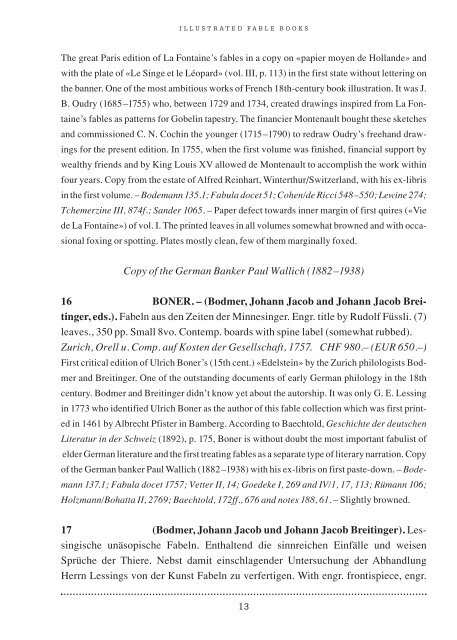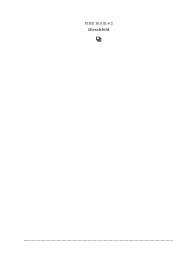FINE BOOK # 4 Aesopus semper vivus - Peter Bichsel · Fine Books
FINE BOOK # 4 Aesopus semper vivus - Peter Bichsel · Fine Books
FINE BOOK # 4 Aesopus semper vivus - Peter Bichsel · Fine Books
Create successful ePaper yourself
Turn your PDF publications into a flip-book with our unique Google optimized e-Paper software.
I L L U S T R A T E D F A B L E B O O K S<br />
The great Paris edition of La Fontaine’s fables in a copy on «papier moyen de Hollande» and<br />
with the plate of «Le Singe et le Léopard» (vol. III, p. 113) in the first state without lettering on<br />
the banner. One of the most ambitious works of French 18th-century book illustration. It was J.<br />
B. Oudry (1685–1755) who, between 1729 and 1734, created drawings inspired from La Fontaine’s<br />
fables as patterns for Gobelin tapestry. The financier Montenault bought these sketches<br />
and commissioned C. N. Cochin the younger (1715 –1790) to redraw Oudry’s freehand drawings<br />
for the present edition. In 1755, when the first volume was finished, financial support by<br />
wealthy friends and by King Louis XV allowed de Montenault to accomplish the work within<br />
four years. Copy from the estate of Alfred Reinhart, Winterthur/Switzerland, with his ex-libris<br />
in the first volume. – Bodemann 135.1; Fabula docet 51; Cohen/de Ricci 548–550; Lewine 274;<br />
Tchemerzine III, 874f.; Sander 1065. – Paper defect towards inner margin of first quires («Vie<br />
de La Fontaine») of vol. I. The printed leaves in all volumes somewhat browned and with occasional<br />
foxing or spotting. Plates mostly clean, few of them marginally foxed.<br />
Copy of the German Banker Paul Wallich (1882–1938)<br />
16 BONER. – (Bodmer, Johann Jacob and Johann Jacob Breitinger,<br />
eds.). Fabeln aus den Zeiten der Minnesinger. Engr. title by Rudolf Füssli. (7)<br />
leaves., 350 pp. Small 8vo. Contemp. boards with spine label (somewhat rubbed).<br />
Zurich, Orell u. Comp. auf Kosten der Gesellschaft, 1757. CHF 980.– (EUR 650.–)<br />
First critical edition of Ulrich Boner’s (15th cent.) «Edelstein» by the Zurich philologists Bodmer<br />
and Breitinger. One of the outstanding documents of early German philology in the 18th<br />
century. Bodmer and Breitinger didn’t know yet about the autorship. It was only G. E. Lessing<br />
in 1773 who identified Ulrich Boner as the author of this fable collection which was first printed<br />
in 1461 by Albrecht Pfister in Bamberg. According to Baechtold, Geschichte der deutschen<br />
Literatur in der Schweiz (1892), p. 175, Boner is without doubt the most important fabulist of<br />
elder German literature and the first treating fables as a separate type of literary narration. Copy<br />
of the German banker Paul Wallich (1882–1938) with his ex-libris on first paste-down. – Bodemann<br />
137.1; Fabula docet 1757; Vetter II, 14; Goedeke I, 269 and IV/1, 17, 113; Rümann 106;<br />
Holzmann/Bohatta II, 2769; Baechtold, 172ff., 676 and notes 188, 61. – Slightly browned.<br />
17 (Bodmer, Johann Jacob und Johann Jacob Breitinger). Lessingische<br />
unäsopische Fabeln. Enthaltend die sinnreichen Einfälle und weisen<br />
Sprüche der Thiere. Nebst damit einschlagender Untersuchung der Abhandlung<br />
Herrn Lessings von der Kunst Fabeln zu verfertigen. With engr. frontispiece, engr.<br />
13



